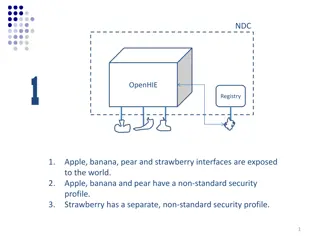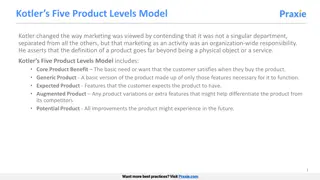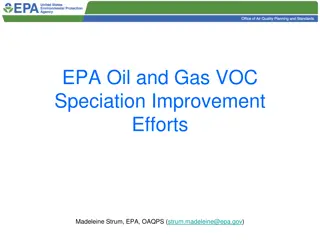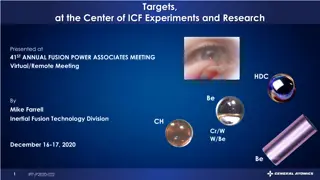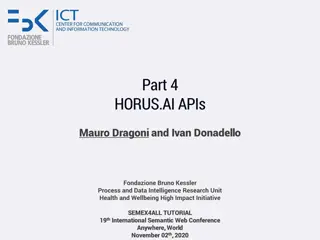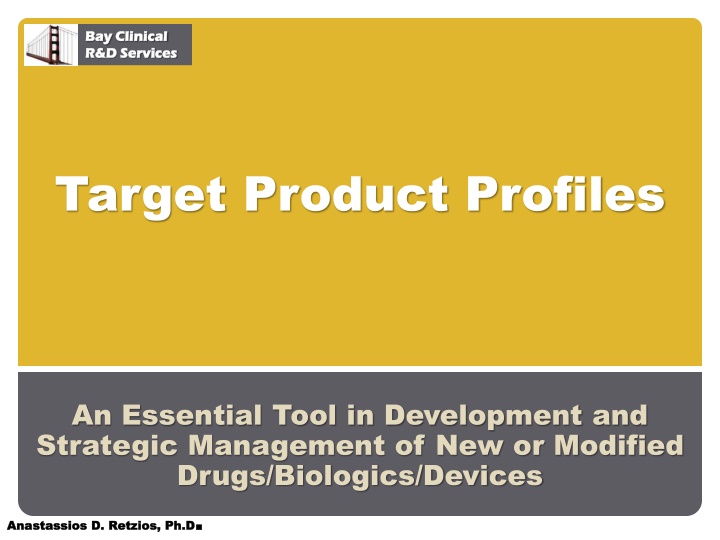
Target Product Profiles in Pharmaceutical Industry
Learn about the significance of Target Product Profiles (TPPs) in pharmaceutical development, strategic management, and Quality by Design (QbD) principles. Discover how detailed TPPs play a crucial role in the success and cost estimation of drug development programs.
Download Presentation

Please find below an Image/Link to download the presentation.
The content on the website is provided AS IS for your information and personal use only. It may not be sold, licensed, or shared on other websites without obtaining consent from the author. If you encounter any issues during the download, it is possible that the publisher has removed the file from their server.
You are allowed to download the files provided on this website for personal or commercial use, subject to the condition that they are used lawfully. All files are the property of their respective owners.
The content on the website is provided AS IS for your information and personal use only. It may not be sold, licensed, or shared on other websites without obtaining consent from the author.
E N D
Presentation Transcript
Bay Bay Clinical Clinical R&D Services R&D Services Target Product Profiles An Essential Tool in Development and Strategic Management of New or Modified Drugs/Biologics/Devices Anastassios D. Retzios, Ph.D. . Anastassios D. Retzios, Ph.D
What is a Target Product Profile? A Target Product Profile (TPP) is a summary of the drug development program described in terms of labeling concepts It is prepared by the all departments of the company involved in the development of the therapeutic or diagnostic agent Its submission to the FDA is voluntary but has specific benefits* The TPP is a living document evolving and maturing with increasing knowledge and experience
TTPs and the Pharmaceutical Industry Detailed TPPs have a key role in the pharmaceutical industry in Strategic Program Management (SPM)* TPPs explore various labeling scenarios Target, Minimal, Optimal TPPs estimate (for each scenario) Probabilities of Success Development Costs Personnel Manufacturing Market Penetration / Competitors
TPP and Quality by Design (QdD) Quality by Design (QdB) is a development methodology based on detailed scientific understanding of the test therapeutic agent (its properties and manufacturing process), has predefined objectives and employs effective controls and risk management Quality by Design principles are included in the ICH guidances Q8, Q9 and Q10 These guidances deal mostly with the quality and risk management of the drug/biologic product. As such, there are provisions therein that address the Quality Target Product Profile (QTTP), an essential subcomponent of the TTP ICH and FDA are currently extending key elements of QbD to clinical trials. Draft guideline E8(R1): General Considerations for Clinical Trials, May 2019
Assembly of an Industry TPP A common template should be used for all products, bringing consistency to the process A TPP is assembled for each product entering development and each new indication for an existing drug/biologic Input is elicited from various departments. Assembling a TPP is a team effort The owner of the TPP is usually the Project Manager who coordinates the activities of specific product development team The TPP constitutes an important evaluation tool in gate reviews , if such reviews are enabled by the organization
TPP General Statement Project Name (Name) Project Description Summary description of the product Project Category Is the project is an additional indication for an existing drug or a new project? Strategic Fit and Value How well does this drug/biologic fit with the core expertise and capabilities of the company? Value to Patients What is the specific value of this drug/biologic to patients? Does it offer therapeutic, safety or ease of use advantages over existing or upcoming drugs/biologics Does the company have a competitive advantage? Company s competitive position Brief summary of the IP position regarding this drug Company s IP position Rationale for success Brief summary as to why the developing team believes that this product would Factors for success Brief statement as to the company s core competencies and market conditions that would drive a successful outcome Key risk factors Brief statement identifying possible risks Consequences for not pursuing the project What would happen if this project is not pursued? Possible alternatives to this project Are there any alternatives to this project?
TPP Description of Therapeutic Agent Optimistic Optimistic Target Target Minimal Minimal
TPP Summary of Efficacy Primary Indication Primary Indication Primary Clinical Endpoint (s) Primary Clinical Endpoint (s) Target Patient Population Target Patient Population Route of Administration Route of Administration Treatment Regimen Treatment Regimen Clinical Outcome 1 Clinical Outcome 2 Meets the primary and a number of secondary endpoints that may result in claims Meets the primary endpoint(s) of the pivotal study (or studies) >Target Or =Target >Target Or =Target >Target (if more than the target routes are tested) Or =Target > Lower doses and/or less frequent administration may provide advantages Target (Describe target regimen) Optimistic Optimistic Provide entries if more than one primary endpoint Target (Describe target population) Target (Describe target route(s) of administration) Target Target = Target = Target (if essential for regulatory success) =Target Or <Target If successful in a more limited population = Target Or < Target If the least desirable tested route is successful > Higher dosing and more frequent administration than target that may still be acceptable Minimal Minimal
TPP Summary of Safety Primary Indication Drug Interactions Primary Indication Drug Interactions Safety Safety Precautions Precautions Contra- - indications Contra indications Clinical Non-Clinical >Target if fewer and less severe AE profile Or =Target >Target if fewer and less severe interactions Or =Target >Target if no or fewer precautions Or =Target >Target if no or fewer contraindications Or =Target Optimistic Optimistic Target safety is usually equivalent to the known safety of the same class or similar classes of compounds that have been approved Laboratory or other findings similar to those observed for the same class or similar classes of compounds that have been approved Interactions similar to those observed for the same class or similar classes of compounds that have been approved Precautions similar to those observed for the same class or similar classes of compounds that have been approved Contraindications similar to those observed for the same class or similar classes of compounds that have been approved Target Target = Target = Target =Target = Target = Target Minimal Minimal (<Target would be acceptable if risk/benefit ratio is favorable) (<Target would be acceptable if risk/benefit ratio is favorable) (<Target acceptability criteria should be explained) (<Target acceptability criteria should be explained) (<Target acceptability criteria should be explained)
Additional Elements of TPP The TPP may contain additional elements regarding: Product design and formulation Contaminants Any delivery system associated with the drug Projected dates of submissions, regulatory approval and launch Cost of goods, pricing, market size Target, optimistic and minimal conditions may be set for these elements
How to Assemble a TPP Utilize the following: Define properties of the drug in preclinical development Pharmacokinetics Toxicology Efficacy in animal models Select target indication(s) Structure a TPP for each indication that may require additional development Examine approved claims of competitors (efficacy and safety) Examine the competitive environment for compounds currently in development and likely to be approved in the near future Elaborate on minimal and optimal profiles
TPP as a Strategic Planning Tool Clinical Development TPP scenarios can be used for: Design of clinical studies Design of detailed timelines Evaluation of risks and creation of mitigation plans Estimation of the possibility of success Estimate budgets/personnel Regulatory /Clinical Estimation of likely approval dates in various geographies Manufacturing Evaluation of manufacturing options/expenditure Marketing Estimation of costs of goods Estimation of pricing Estimation of marketing campaign costs Estimation market penetration (focus groups)
Utilizing TPPs in Development TPPs utilized correctly can: Assess risks and create risk mitigation plans for all stages of clinical development Assign a probability of success at each phase of clinical development and each indication targeted Assumptions of probability of success at any stage of development should be explained and contrasted to industry norms Promote a team-based approach Compiling TPPs is a team-based activity that enhances collaboration among project team members and increases awareness of the project s critical issues throughout the organization
Risk Identification and Mitigation Plan (Clinical Development) Ownership (Enter Appropriate Department) Risk of Occurrence (1-5) Impact (1 to 5) Date for Action Risk # Risk Mitigation Action Plan 1 Phase 1 study (Describe Risk) Phase 1 study (Describe Risk) 1= minimal impact 5 = maximal impact 1= minimal impact 5 = maximal impact 1= unlikely 2= possible 3= probable 4= likely 5= very likely 1= unlikely 2= possible 3= probable 4= likely 5= very likely Enter mitigation plan (Note if the occurrence of the outlined risk leads to program discontinuation) Enter mitigation plan (Note if the occurrence of the outlined risk leads to program discontinuation) 2 Phase 2 study: (Describe Risk) Phase 2 study: (Describe Risk) 1= minimal impact 5 = maximal impact 1= minimal impact 5 = maximal impact 1= unlikely 2= possible 3= probable 4= likely 5= very likely 1= unlikely 2= possible 3= probable 4= likely 5= very likely Enter mitigation plan (Note if the occurrence of the outlined risk leads to program discontinuation) Enter mitigation plan (Note if the occurrence of the outlined risk leads to program discontinuation) 3 Phase 3a study (Describe Risk) Phase 3a study (Describe Risk) 1= minimal impact 5 = maximal impact 1= minimal impact 5 = maximal impact 1= unlikely 2= possible 3= probable 4= likely 5= very likely 1= unlikely 2= possible 3= probable 4= likely 5= very likely Enter mitigation plan (Note if the occurrence of the outlined risk leads to program discontinuation) Enter mitigation plan (Note if the occurrence of the outlined risk leads to program discontinuation) 4 Phase 3b study (Describe Risk) Phase 3b study (Describe Risk) 1= minimal impact 5 = maximal impact 1= minimal impact 5 = maximal impact 1= unlikely 2= possible 3= probable 4= likely 5= very likely 1= unlikely 2= possible 3= probable 4= likely 5= very likely Enter mitigation plan (Note if the occurrence of the outlined risk leads to program discontinuation) Enter mitigation plan (Note if the occurrence of the outlined risk leads to program discontinuation) 5 Regulatory Regulatory 1= minimal impact 5 = maximal impact 1= minimal impact 5 = maximal impact 1= unlikely 2= possible 3= probable 4= likely 5= very likely 1= unlikely 2= possible 3= probable 4= likely 5= very likely Enter mitigation plan (Note if the occurrence of the outlined risk leads to program discontinuation) Enter mitigation plan (Note if the occurrence of the outlined risk leads to program discontinuation)
Example of Development Plan Risk Tree Analysis based on TPP Path Regulatory Phase I Phase III Phase II Candidate Development Preclinical Probability Optimistic P = Target Success TBD P = 0.9 P = 1.0 Minimal Success P = P = 0.7 Success Failure TBD P = 0.7 Stop Success TBD P = 0.7 Success Stop TBD Success P = 0.76 Stop TBD P = 0.95 Stop TBD Stop TBD SUM
Summary TPPs are excellent tools for: Planning the development of a novel agent Obtaining accurate and helpful feedback from regulatory agencies Estimating the project risks Evaluating the possibility of success Comparing possibilities of success of other product configurations and indications Evaluating the total costs of development Estimating the market opportunity Retaining focus throughout the development process








